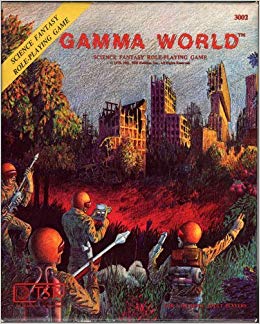I started to feel that I didn’t know roleplaying games well enough so I came up with the plan to read a roleplaying game corebook for every year they have been published. Selection criteria is whatever I find interesting.

For 1978, my game of choice was Gamma World. Another option would have been the original Advanced Dungeons & Dragons Player’s Handbook, which was a huge leap ahead in how roleplaying games were presented. However, I remember looking at all those Gamma World adverts in the 90’s in Dragon magazine and being intrigued. So Gamma World it was!
Very much based on the 1976 game Metamorphosis Alpha, Gamma World is a postapocalyptic roleplaying game in which civilization has regressed to a primitive state and mutants roam the earth. It’s a very pure implementation of hexcrawl-style design where the idea is that player characters explore terrain as they move about, meeting different creatures and exploring the ruins of the old world.
Gamma World lifts from its predecessor the character creation system focused on various beneficial and harmful mutations. It also has the genetically pure humans blessed with charisma although plants have now been relegated to a supporting role.
While Metamorphosis Alpha was closely tied to its setting, Gamma World is much more open-ended. The referee is advised to make a map of their own, possibly based on a real world map, and populate it with postapocalyptic things for the characters to explore. This DIY feeling pervades the game: The referee is assumed to make up new monsters, treasures, robots and so on.
Gamma World has one wonderful feature that elevates it above any game I’ve read so far: A long, involved example of play that communicates what the play experience is supposed to be like. It might literally be the best such example I’ve ever read in a roleplaying game.
Not content to just include a brief dialogue between the GM and the players, the example explains how Omar the Referee prepares for the game by coming up with terrain features and making smaller maps of buildings. It details a possible starting scenario for the game: The characters are young tribesmen sent out on a coming-of-age ritual to explore taboo territories. Finally, it has a dialogue between the Referee and the Caller, the player who speaks for the entire player group.
The example of play spells out of a lot of the play culture around these games, stuff that you usually have to infer between the lines. Because of it, it’s much easier to grasp how this is supposed to work.